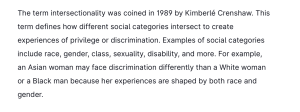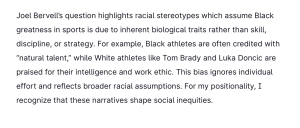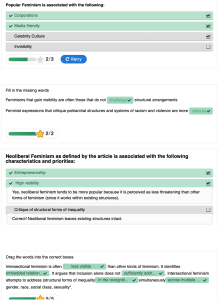3
Section One: The Fundamentals
A) Keywords
Exercise 1:
Briefly (in 100 words or less) define one of the keywords in the padlet (including one that you. may have added yourself).

|
B) Representing Race
Exercise 2: Notebook Prompt
In about 50-70 words, consider Joel Bervell’s question: why do we feel the need to extrapolate the athleticism of one Black athlete to all Black people when we do not do the same for white athletes?
Try to think of examples when this happens, making sure to reflect on your own positionality.

|
C) Gender, Race & Sport
Exercise 3: Notebook Prompt
What are some strategies for resistance that Rajack and Joseph identify in their article as a means of pushing back against and resisting misogynoir?
|
|
Section Two: Making Connections
A) Athlete Activism
Exercise 3: Padlet Prompt
Do athletes have a responsibility to use their platform for social change? Why or why not? Please remember to record your response in both the padlet below and in your Notebook.
B) Athlete Activism & Feminism
Exercise 4: Complete the activities

Exercise 5: Notebook Prompt
What do the authors of the article call for as a way of challenging how mainstream sports journalism privileges neoliberal feminist concerns? (100 words max.)

|
C) Corporate social justice
Exercise 6: Padlet Poll
|
|
Section Three: Taking a shot
Module Assignment (submit as part of notebook and separately through Blackboard mini assignment #1 portal)
“I Am Ali” Analysis:
This is a documentary about the famous boxer Muhammad Ali. However, it is not just about his boxing career. It is also about how he used his platform to challenge systemic racism, religious discrimination, and war. Evidence of this was gathered through interviews, audio recordings and archived footage. One of the main strategies Ali used was his unapologetic embrace of his identity as a Black Muslim. From Cassius Clay to Muhammad Ali, he publicly converted to Islam. The name change was also a rejection of the legacy of slavery and white supremacy that was embedded in the name. This was a powerful form of resistance, as it challenged the expectation that Black athletes should conform to societal standards and be unpolitical. Using his religion and opposition to racial injustice, Ali refused to join the Vietnam War when he was drafted. This further demonstrates his dedication to using his platform for activism. His famous statement, “No Viet Cong ever called me the N-word,” highlights the intersection of race, religion, and politics in his activism. Due to this activism, he faced backlash that would strip his titles and widespread criticism by the media and other sources. This is the reality for many marginalized athletes if they speak out against injustices they have faced. It is also what makes athletes stay silent in fear of jeopardizing their careers and reputations. Knowing this, Ali fought against oppression and for equality. Though backlash was mostly what Ali had seen, there was support from marginalized communities that he appreciated the most. Ali leveraged his fame as a boxer to speak out against injustice and promote his ideals. This example shapes how we understand sports as not just entertainment but also a site of political struggle. As discussed in the intersectionality framework, Ali’s activism cannot be isolated from his intersecting identities as a Black man and a Muslim. The documentary shows how sports are ingrained in social and political contexts, and how athletes like Ali use their platforms to challenge systemic oppression. This is what Raymond Boyle and Richard Haynes were referring to when they said “Sport, in this sense, becomes a site of cultural and political conflict.” (2009). To conclude, sports are a place for resistance and empowerment.
Refrences
Boyle, R., & Haynes, R. (2009). The Race Game: Media Sport, Race and Ethnicity. Power Play, 107–121. https://doi.org/10.3366/edinburgh/9780748635924.003.0006


